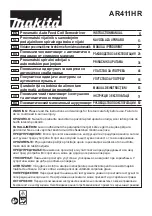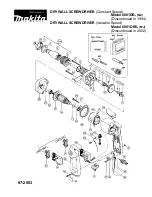
9 ENGLISH
3.
To maintain product SAFETY and RELIABILITY,
maintenance and repairs should be performed
by Makita Authorized Service Centers, always
using Makita replacement parts.
4.
Follow local regulations when disposing of the
tool.
SAVE THESE INSTRUCTIONS.
WARNING:
DO NOT let comfort or familiarity
with product (gained from repeated use) replace
strict adherence to safety rules for the subject
product. MISUSE or failure to follow the safety
rules stated in this instruction manual may cause
serious personal injury.
PARTS DESCRIPTION
►
Fig.1:
1.
Trigger
2.
Contact arm
3.
Actuation mode
selector
4.
Magazine
5.
Hook
6.
Driving
mode switch knob
INSTALLATION
Selecting compressor
The air compressor must comply with the requirements
of EN60335-2-34.
Pressure regulators must be used to limit air pressure to
the rated pressure of the tool where air supply pressure
exceeds the tool's rated pressure. Failure to do so may
result in serious injury to tool operator or persons in the
vicinity.
Selecting air hose
CAUTION:
Low air output of the compressor,
or a long or smaller diameter air hose in rela-
tion to the screwdriving frequency may cause a
decrease in the driving capability of the tool.
Use a high pressure resistant air hose. Use an air hose
as large and as short as possible to assure continuous,
efficient screw-driving operation.
►
Fig.2
Lubrication
Before and after use, apply two or three drops of pneu
-
matic tool oil into the air fitting. After applying the oil,
connect the air hose and drive some screws for proper
lubrication.
►
Fig.3:
1.
Air fitting
FUNCTIONAL DESCRIPTION
CAUTION:
Always be sure that the air hose
is disconnected and no fastener is loaded before
adjusting or checking function on the tool.
Driving depth adjuster
CAUTION:
When adjusting driving depth,
always disconnect the air hose.
This tool is equipped with an adjuster to change the screw
driving depth. Turn the adjuster to change the driving depth.
Driving adjustment range is 6 mm. One turn of adjuster
increases/decreases the depth by approximately 0.8 mm.
►
Fig.4:
1.
Deeper
2.
Shallower
Adjust the driving depth as necessary.
►
Fig.5:
1.
Driven too deep (turn clockwise)
2.
Appropriate depth
3.
Driven too shallow
(turn counterclockwise)
Hook
CAUTION:
When using the hook or changing
its position, always disconnect the air hose. Do
not fasten hook onto waist belt, etc.
If the tool
dropped, it may be operated by mistake and cause
personal injury.
CAUTION:
Make sure that the hook is
attached to the tool properly. If unfastened, the
tool can drop and be operated by mistake, which
may cause personal injury.
The hook is useful for hanging up the tool temporarily.
Turn the hook while pushing the bottom. The hook can
be turned by 90°. You can change the mounting side
of the hook. Remove the screw fixing the hook and
change the direction.
►
Fig.6
Driving mode switch
This tool is equipped with two types of driving mode.
Refer to the table below for selecting the driving mode.
The optimum driving mode varies according to the
workpiece material. Fully turn the knob until it clicks to
your desired mode position.
►
Fig.7:
1.
Knob
Screw length/
Material
25 mm
28 mm
32 mm
41 mm
Steel
sheet
backing
0.8 mm
thick
-
0.6 mm
thick
-
0.4 mm
thick
-
Wood backing
When working on general plasterboard, the thickness
9.5 mm, 12.5 mm and 15 mm are suitable.










































